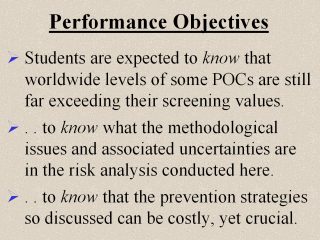 |
At the end of the
this session, students are expected to have a full appreciation of the
issues covered in this second half of the lecture. They should know that
worldwide some POCs are still at levels far exceeding their screening values
(in some places by 30-fold+). They should realize that the type of risk
analysis conducted in this lecture is far from flawless; it is only
exploratory in nature. They should also understand the additional concern
that POCs have a tendency to bioaccumulate in humans. Finally, students
should be familiar with the fact that effective strategies for this type of
prevention could/should come from the following directions: environmental
health policy; regulatory and research activities; residue
monitoring programs; and self awareness/prevention. Of these, the
last approach appears to be most effective. |
